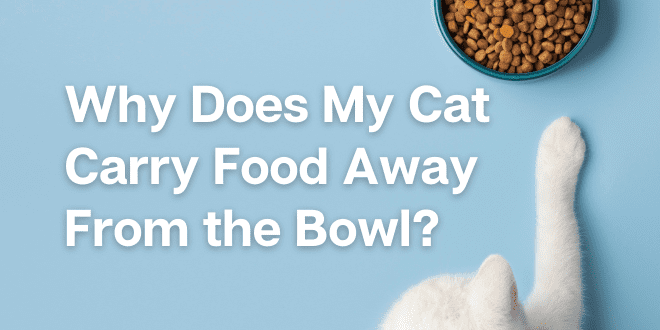
You’ve set up the ideal feeding station for your cat. You picked the perfect bowl and maybe even put a placemat underneath to catch any food or water spills. You’ve done your research and picked top quality food for your cat. Instead of enjoying her meal at the feeding station though, your cat grabs a chunk of wet food or several pieces of dry food in her mouth and dashes off to another location to finish eating. When the cat has swallowed that food she comes back to the bowl and takes another mouthful and dashes off again. Why does the cat keep going back and forth instead of just eating at the feeding station? Here are a few reasons why some cats engage in this behavior.
Protecting the Catch
Going off to a hiding place may allow the cat to eat in peace without having other cats try to steal it away. If you’ve watched nature shows on television you’ve probably seen wild cats often take their catch off to a more hidden area. This instinct exists in domestic cats as well. Even your indoor cat has that same need to protect “prey” from being stolen.
Cats are solitary hunters and they take down small prey that basically provides a meal only for one. The cat doesn’t have the benefit of others helping guard a large catch. The cat is on her own and the best protection is to move to a safer location.

With an indoor cat you may also see this behavior when extra special treats are offered. It’s such a treasured prize that the cat may carry it in her mouth to a preferred area before eating.
Self Protection
In an outdoor environment, the cat chooses a safe place to eat her catch in order to avoid alerting larger predators to her presence. In addition to being hunters, cats are also prey to larger animals so the location chosen is to avoid being put in danger. In an indoor multicat household, one or more of the cats may feel unsafe when eating at the designated feeding station. This is particularly true in homes where there is tension between cats or where one or more cats have bullied another cat away from the bowl.
Cats aren’t Social Eaters
Although cats are social, they don’t necessarily feel comfortable eating together in close quarters. If the food is only offered in one location in your home, the cats may tolerate being close together in order to access the resource but that doesn’t mean they aren’t stressed about it. This could cause a cat to grab a mouthful and head off to a safer location. Even if a cat doesn’t move food before eating it, she may eat too quickly in order to spend as little time as possible in the unsafe location.
Create Peace at the Feeding Stations
Just because cats in a multicat home appear to get along doesn’t mean they feel comfortable eating side by side at the food bowl. Don’t put out just one big bowl for all cats to share. Separate food into individual bowls and provide consistency in where you place them for each meal. Space the bowls far enough apart so the cats don’t feel threatened. In the case of a cat who moves away from the bowl before eating, try feeding that kitty in a separate location. For some cats, just not being side by side is good enough but for others, it’s stressful to be in the same room during meals. Pay attention to how your cats get along and especially how they act around the feeding station to determine whether you need to set up additional feeding stations in other locations in the home.
Even if you leave dry food out for cats to nibble on throughout the day, set up multiple areas for them to find that food so no one feels intimidated about crossing another cat’s path.
Food-dispensing toys may also be a help when it comes to easing stress at the feeding station. The puzzle feeders can provide in-between meal activity so the cats don’t get so hungry and stressed. For cats who eat too quickly, food-dispensing toys can help slow the process. You can create or purchase food-dispensing toys for both wet or dry food.
Need More Information?
You can find more specific information on cat behavior and training in the books by best-selling author, Pam Johnson-Bennett. Pam’s books are available at bookstores and online. We’ve included Amazon links here on our website.
If you have a question about your cat’s behavior or health, contact your veterinarian. This article is not intended as a medical diagnosis nor is it a replacement for your cat’s regular veterinary care. This article is for general information purposes only.
